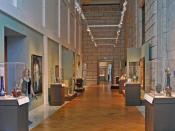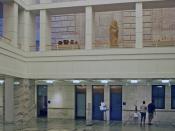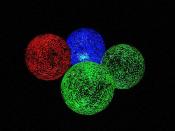Analysis of the "Personification of the River Tigris"ÃÂ Art's existence began with our existence. The earliest artists used cave walls as their canvases. As we advanced so did our art. People began to use different resources to create art. A resource could be rocks or ash. The "Personification of the River Tigris"ÃÂ is a great example of artist ingenuity. This piece is from the late second to early third century. It is from Syria, a Roman city, where it was found as part of a floor in an ancient private home. The piece is 56 3/4 in. x 56 1/4 in., it is a mosaic of stone tesserae, and it is part of the Detroit Institute of Arts' permanent collection. Although this work is old, the art flow chart can still be applied.
Every element is present is this stone mosaic. The lines formed by the gaps in between stones control the pattern's form and help to create a definite rhythm.
This rhythm is most apparent in the circular patterns around the picture of the bearded man. The 2-D shape of the art work makes the bearded man the dominant part of the piece. If the mosaic were 3-D the eyes might concentrate on the shape more than the picture. As it is the eyes move to the center of the piece. This focus on the center can be attributed to the contrast present in the center. The man wears his garment on only one shoulder, he leans to the left, and he is looking to the right. All this is in sharp contrast to the rest of the mosaic which is really just a pattern design. The value is unclear because of the quality of the picture. There seems to be darker values on the left and right, but this could simply be shadows created by bad lighting when the picture of this mosaic was taken. The smooth texture creates more flow and harmony. And the contrast in color moves the eyes from one spot to the next. This can be seen in the circular pattern around the bearded man. The pattern is made to have a much bolder color then any of the other colors, and therefore a certain amount of focus is placed on the pattern.
This mosaic uses almost all of the five principals. There is an obvious balance in this piece. This balance is present in the leaves in each corner, each leaf is the same size and has the same number of parts. The dominant part of the mosaic is the bearded man(as was already discussed). Though the picture does have movement, it lacks the proper movement that the principals of design state. The movement is from the middle-out, and is not the X movement that is usually sought. The proportions are well set and create space. The creation of space is furthered by the economy of the mosaic as well. Nothing is used to little and nothing seems cramped.
Overall this picture has a harmony about it. The center location of the contrasting elements does not disturb this harmony enough to take away from the mosaic's beauty. The mosaic definitely has unity because of this. And because it has unity this mosaic has been very well done.




